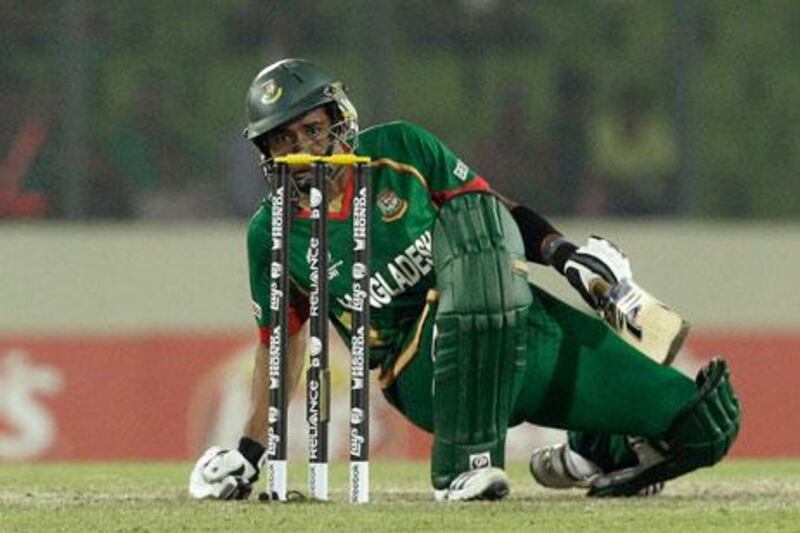After a hype-filled wait, the 2011 World Cup finally exploded to life on the eighth day of competition when Sri Lanka met Pakistan in a match showcasing some of the best cricket talents on the subcontinent.
Until this showdown, however, the only real talking point was the opening ceremonies. Some fantastic eye-catching scenes and items performed with military precision.
However, in terms of cricketing skills and excitement, some of the one-sided games that followed left fans, especially the neutrals, feeling let down.
The tournament opener between Bangladesh and India was billed as an "cracker" but fizzled out as the Indians soon put their enthusiastic neighbours in their place. The gulf in class was evident from the first ball, which Virender Sehwag smacked through the covers!
The start of the tournament saw the Bangladesh fans in high spirits and a packed house was fully behind the home team. However by the time India had posted an insurmountable total the stadium was instead consumed by silence. Was this really the best choice for an opening match?
The Kenya versus New Zealand game turned out to be the sort of game that if you blinked you would miss it. In fact, members of the Chennai paying public should rightly be asking for a refund.
The Kenyans batted first and the scorecard represents a sorry tale of an Associate team that have had little opportunity to play against the major nations in recent times. They were all out for just 69 in 23.5 overs and New Zealand raced to 72 without loss in just eight overs.
Kenya fared marginally better in their game with Pakistan but it was another foregone conclusion, and another box office flop.
In a similar fashion, the Canadians were outclassed by Sri Lanka. A tremendous atmosphere was generated by the Hambantota fans, but even they had seen enough well before the end and the last few overs were played out to a half full stadium.
Holland and Ireland, who both possess some fine players, put up a much more competitive performances, but the clear lack of interest in the World Cup from the viewing public needs addressing.
In what convoluted way and in what respect does the International Cricket Council (ICC) expect teams like Kenya and Canada to be competitive against the Test playing teams, without giving them any regular opportunities against the leading nations?
Surely the Associate teams should be encouraged to play against better opposition every year, so they are given the chance to gauge their strengths and weaknesses and improve their cricket. Such teams should be invited to participate in three or four one day tournaments. Such exposure would be invaluable to ensure the lesser are able to perform on the big occasions.
Rashid Latif, the head coach of the Afghanistan team which narrowly missed out on qualifying for the World Cup, recently spoke to PakPassion.net and voiced his criticism on this aspect.
"Associate members play barely 15 matches in a year which is why they are not improving their cricket and are stagnated at the same place where they started," he said.
One needs look no further than Kenya to prove Latif's hypothesis. After a memorable debut in the 1996 World Cup and qualification for the semi-finals in the 2003 tournament, they have regressed to a stage where they are no longer deemed competitive by observers of this game.
The ICC has recently announced that the next World Cup will be reduced to a 10 team competition. This move only further reduces the Associate member opportunities to play against Test playing nations.
It is a classic case of eliminating the problem rather than solving it. It may reduce the number of one-sided matches but will it really improve the standard of cricket and allow it to become a truly global sport? As a current player recently remarked, will we really have any right to call it a "World" Cup? Instead of trying to prepare the weaker teams for tournaments such as the World Cup, the ICC is instead cutting of their air supply.
As well as looking into the issue of Associate teams and their limited opportunities, the ICC needs to look at the fixture schedule of such a prestigious tournament.
By having the opening six matches as potentially one-sided games, they are no doubt turning many viewers away from their television sets. More interest would have been generated if they had arranged the fixtures so that there were some "big" matches at the start.
While much of the on-field action has been one sided, the commentary has failed to provide much excitement either. When the cricket is dull, viewers look to the commentators to provide some insight and entertainment.
It is appreciable that the broadcasters have to try and find an array of international commentators, but the reality is that some of them are just former players who are stating the obvious and making the most dull and uninteresting observations.
The viewers want to listen to funny anecdotes, to hear some technical insight, and extract knowledge from the commentator's own experience.
The likes of Sunil Gavaskar, Wasim Akram and Rameez Raja may well be high profile commentators, but the reality is that their commentaries are flat, dull and as uninspiring as the cricket has been in the first week of the World Cup.





